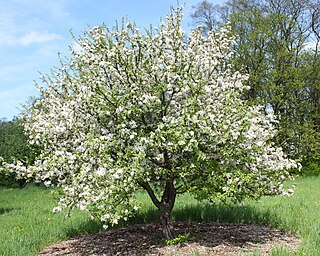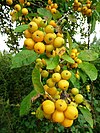
Malus is a genus of about 32–57 species of small deciduous trees or shrubs in the family Rosaceae, including the domesticated orchard apple, crab apples and wild apples.
A crab is a water-dwelling creature, a decapod crustacean of the infraorder Brachyura. A related common meaning is crab meat.

Malus sieversii is a wild apple native to the mountains of Central Asia in southern Kazakhstan. It has recently been shown to be the primary ancestor of most cultivars of the domesticated apple. It was first described as Pyrus sieversii due to its similarities with pears in 1833 by Carl Friedrich von Ledebour, a German naturalist who saw them growing in the Altai Mountains.

Malus sylvestris, the European crab apple, also known as the European wild apple or simply the crab apple, is a species of the genus Malus, native to Europe and western Asia. Its scientific name means "forest apple".

Malus floribunda, common name Japanese flowering crabapple, Japanese crab, purple chokeberry, or showy crabapple, originates from Japan and East Asia. It may be a hybrid of M. toringo with M. baccata, in which case it would be written as Malus × floribunda.

Malus hupehensis, common names Chinese crab apple, Hupeh crab or tea crabapple, is a species of flowering plant in the apple genus Malus of the family Rosaceae.

Malus fusca, with the common names Oregon crabapple and Pacific crabapple, is a species of crabapple native to western North America.

Malus baccata is an Asian species of apple known by the common names Siberian crab apple, Siberian crab, Manchurian crab apple and Chinese crab apple. It is native to many parts of Asia, but is also grown elsewhere as an ornamental tree and for rootstock. It is used for bonsai. It bears plentiful, fragrant, white flowers and edible red to yellow fruit of about 1 cm diameter.

Malus ioensis, known as the Iowa crab or prairie crabapple, is a species of crabapple tree native to the United States. The most common variety, M. ioensis var. ioensis, is found primarily in the prairie regions of the upper Mississippi Valley. Another variety, M. ioensis var. texana, or the Texas crabapple, is found only in a small region of central Texas.

Malus prunifolia is a species of crabapple tree known by the common names plumleaf crab apple, plum-leaved apple, pear-leaf crabapple, Chinese apple and Chinese crabapple. It is native to China, and is grown elsewhere for use as an ornamental tree or as rootstock. It reaches from between 3 and 8 meters tall and bears white flowers and yellow or red fruit.

Malus rockii is a crabapple species in the family Rosaceae. It is native to China and Bhutan.

Malus spectabilis is a species of crabapple known by the common names Asiatic apple, Chinese crab, HaiTang and Chinese flowering apple.

Malus × kaido, the midget crab apple or Kaido crab apple, is a hybrid species of genus Malus in the rose family, Rosaceae. It is a naturally-occurring hybrid of Malus baccata and M. spectabilis. It is native to north-central and northeastern China.
Spilonota lechriaspis, the apple fruit licker, is a moth of the family Tortricidae. It is found in eastern Russia, China, the Korean Peninsula and Japan.
Stigmella oxyacanthella is a moth of the family Nepticulidae, found in Europe and North America. The larvae are leaf miners feeding inside the leaves of trees and shrubs, such as hawthorn, apple and pear.
Chinese crab apple is a common name for several plants and may refer to:
Applecrabs are various hybrids between crabapples and apples. They are bred for varying reasons, including disease resistance and use in cold climates because they are often hardier than apple trees and their fruit has the good eating qualities of apples.
The PRI disease resistant apple breeding program is a joint project of the Purdue University, Rutgers University, and the University of Illinois, to breed apple cultivars to be resistant to apple scab. The initialism stands for the three involved universities: Purdue, Rutgers and Illinois.

Malus × robusta, called Siberian crab apple along with other members of its genus, is a hybrid species of flowering plant in the family Rosaceae. It is the result of a cross between Malus baccata and Malus prunifolia. It is being studied for its resistance potential to fire blight. Known for its attractive fruit that remain on the tree well into winter, its cultivar 'Red Sentinel' has gained the Royal Horticultural Society's Award of Garden Merit as an ornamental.

Malus × zumi is a naturally occurring hybrid species of crabapple in the family Rosaceae, native to Japan, and a garden escapee in the US state of Ohio. Its parents are Manchurian crab apple Malus mandshurica and Siebold's crabapple Malus sieboldii. It is used as a salt‑tolerant rootstock for apples, Malus domestica, as it can survive NaCl concentrations up to 0.6%. A number of ornamental cultivars are available, including 'Golden Hornet' and 'Professor Sprenger'.















